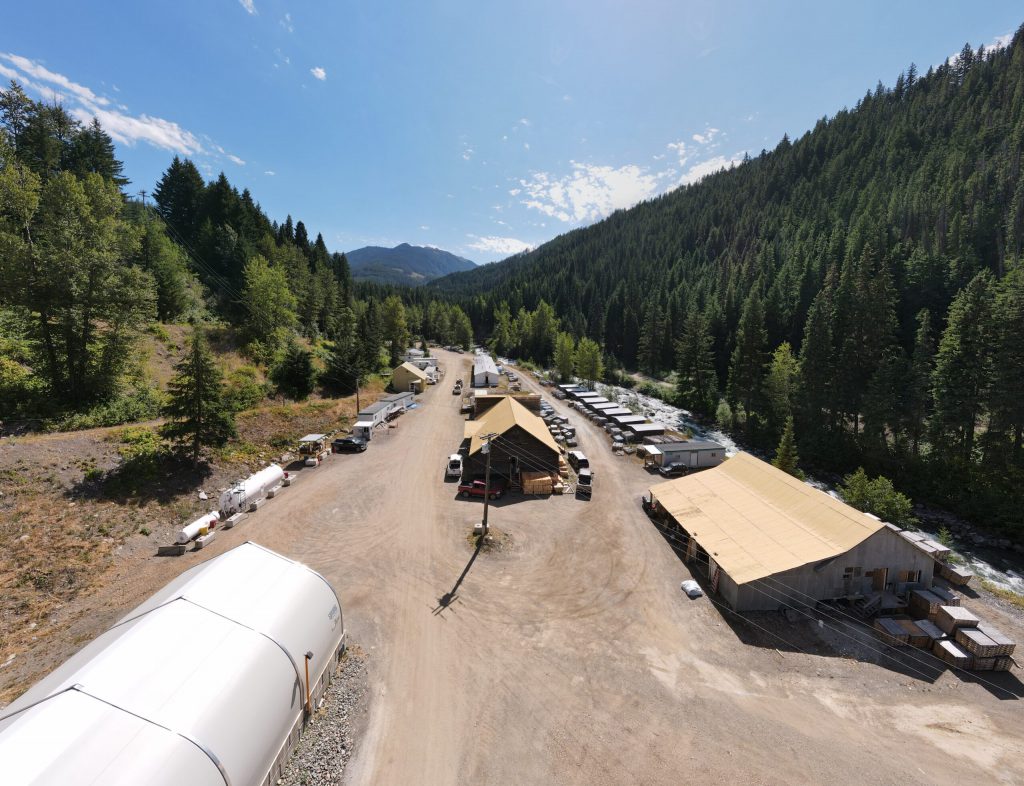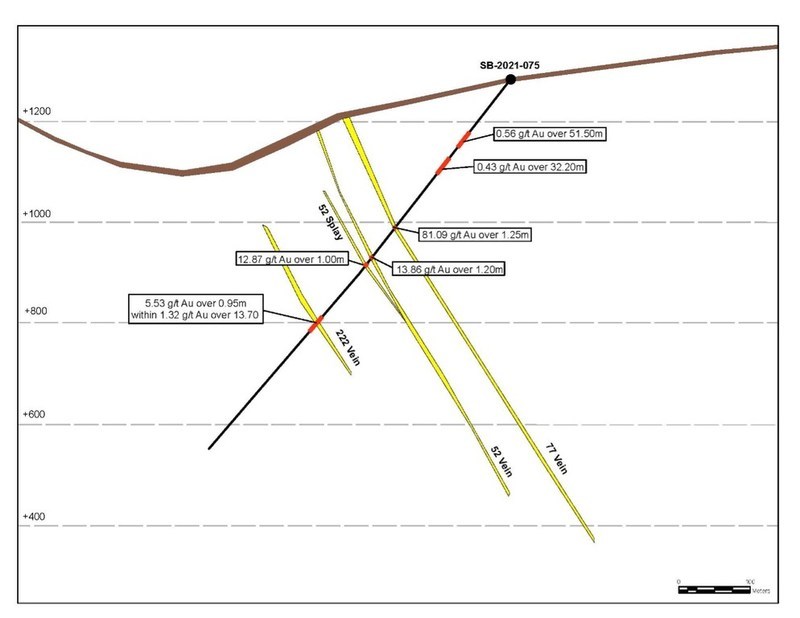Talisker Intercepts High Grade Results from Unexplored Historic Gap Between Bralorne and Pioneer Extending the 77 Vein

Talisker Resources Ltd. (“Talisker” or the “Company“) (TSX: TSK) (OTCQX: TSKFF) is pleased to announce high grade results from drill hole SB-2021-075 highlighted by 81.09 g/t Au over 1.25 metres on the 77 Vein at its 100% owned flagship Bralorne Gold Project.
Key Points:
- The 77 Vein was intersected between 373.75-375.0 metres highlighted by 81.09 g/t Au over 1.25 metres.
- Hole SB-2021-075 increases the total intercepts on the 77 Vein to 11.
- The 77 Vein was the most productive and high grade vein on the Project, historically averaging 17.7g/t Au and was mined to a depth of 1.9 kilometres.
- The 52 Vein was intersected between 456.0 and 457.20 metres highlighted by 13.86 g/t Au over 1.20 metres.
- Hole SB-2021-075 increases the total intercepts on the 52 Vein to 11.
- The 52 Vein Splay was intersected between 474.55 and 475.55 metres, highlighted by 12.87 g/t Au over 1.0 metre.
- Two shallow zones of low grade bulk-tonnage were defined, returning 0.56 g/t Au over 51.5 metres (236.40 and 287.90 metres depth) and 0.43 g/t Au over 32.2 metres (325.30 and 357.50 metres depth).
Terry Harbort, President and CEO of Talisker commented, “Hole 075 demonstrates the excellent continuity of the 77 Vein increasing the strike to 1,100 metres from historic workings.”
Six diamond drills and 1 RC drill are currently operating at the Bralorne Gold Project. A total of 77,150 metres consisting of 148 holes of a planned and fully funded 100,000 metre program has been drilled at the Project this year with a total of 97,464 metres (179 holes) since Talisker initiated drilling in February 2020.  There are 54 holes consisting of 17,366 samples are currently at the assay laboratory and are expected to be received by the Company shortly.
SB-2021-075 Hole Description
- Complete results have been received for this hole.
- Located in the Bralorne East block and centrally located within the granitic intrusive.
- Intersected granitic intrusive from surface to 356 metres followed by diorite to 831 metres, then granitic intrusive to 925 metres followed by sheared ultramafic rocks within the Cadwallader fault to completion at 961.9 metres.
- Bulk mineralization related to the 51BFW Vein intersected from 236.40 to 287.90 metres.
- Bulk mineralization related to newly discovered veins in the hanging wall of the 77 Vein from 325.30 to 357.50 metres.
- 77 Vein intersected from 373.75 to 375 metres with visible gold.
- 52 Vein intersected from 456.0 to 457.20 metres with visible gold.
- 52 Vein Splay intersected from 474.55 to 475.55 metres with visible gold.
- Bulk mineralization related to the 222 Vein intersected from 616.75 to 630.45 metres with visible gold.
- Major vein structures intersected are considered classic Bralorne crack-seal quartz-carbonate veins with densely banded sulphide septae hosting fine-grained arsenopyrite and pyrite mineralization with strong silica-sericite alteration halos.
- Zones of bulk mineralization are hosted in both the granitic intrusive and diorite as zones of increased veinlet density associated with strong silica-sericite alteration and disseminated pyrite-arsenopyrite mineralization.
Qualified Person
The technical information contained in this news release relating to the drill results at the Bralorne Gold Project has been approved by Leonardo de Souza (BSc, AusIMM (CP) Membership 224827), Talisker’s Vice President, Exploration and Resource Development, who is a “qualified person” within the meaning of National Instrument 43-101, Standards of Disclosure for Mineral Projects.
About Talisker Resources Ltd.
Talisker (taliskerresources.com) is a junior resource company involved in the exploration of gold projects in British Columbia, Canada. Talisker’s projects include two advanced stage projects, the Bralorne Gold Complex and the Ladner Gold Project, both advanced stage projects with significant exploration potential from historical high-grade producing gold mines, as well as its Spences Bridge Project where the Company holds ~85% of the emerging Spences Bridge Gold Belt and several other early-stage Greenfields projects. With its properties comprising 296,983 hectares over 346 claims, three leases and 198 crown grant claims, Talisker is a dominant exploration player in the south-central British Columbia. The Company is well funded to advance its aggressive systematic exploration program at its projects.
For further information, please contact:
Terry Harbort President and CEO
Terry.harbort@taliskerresources.com
+1 416 361 2808
Sample Preparation and QAQC
Drill core at the Bralorne project is drilled in HQ to NQ size ranges (63.5mm and 47.6mm respectively). Drill core samples are minimum 50 cm and maximum 160 cm long along the core axis. Samples are focused on an interval of interest such as a vein or zone of mineralization. Shoulder samples bracket the interval of interest such that a total sampled core length of not less than 3m both above and below the interval of interest must be assigned. Sample QAQC measures of unmarked certified reference materials (CRMs), blanks, and duplicates are inserted into the sample sequence and make up 9% of the samples submitted to the lab for holes reported in this release. Sample preparation and analyses is carried out by ALS Global in North Vancouver, British Columbia, Canada and SGS Canada in Burnaby, British Columbia, Canada. Drill core sample preparation includes drying in an oven at a maximum temperature of 60°C, fine crushing of the sample to at least 70% passing less than 2 mm, sample splitting using a riffle splitter, and pulverizing a 250 g split to at least 85% passing 75 microns (ALS code PREP-31 / SGS code PRP89). Gold in diamond drill core is analysed by fire assay and atomic absorption spectroscopy (AAS) of a 50g sample (ALS code Au-AA26 / SGS code GO_FAA50V10), while multi-element chemistry is analysed by 4- Acid digestion of a
0.25 g sample split with detection by inductively coupled plasma mass spectrometer (ICP-MS) for 48 elements (Ag, Al, As, Ba, Be, Bi, Ca, Cd, Ce, Co, Cr, Cs, Cu, Fe, Ga, Ge, Hf, In, K, La, Li, Mg, Mn, Mo, Na, Nb, Ni, P, Pb, Rb, Re, S, Sb, Sc, Se, Sn, Sr, Ta, Te, Th, Ti, Tl, U, V, W, Y, Zn, Zr). Gold assay technique (ALS code Au-AA26 / SGS code FAA50V10) has an upper detection limit of 100 ppm. Any sample that produces an over-limit gold value via the gold assay technique is sent for gravimetric finish (ALS method Au-GRA22 / SGS method GO_FAG50V) which has an upper detection limit of 1,000 ppm Au. Samples where visible gold was observed are sent directly to screen metallics analysis and all samples that fire assay above 1 ppm Au are re-analysed with method (ALS code Au-SCR24 / SGS code – 6 – GO_FAS50M) which employs a 1kg pulp screened to 100 microns with assay of the entire oversize fraction and duplicate 50g assays on the undersize fraction. Where possible all samples initially sent to screen metallics processing will also be re-run through the fire assay with gravimetric finish provided there is enough material left for further processing.
Caution Regarding Forward-Looking Information
Certain statements contained in this press release constitute forward-looking information. These statements relate to future events or future performance. The use of any of the words “could”, “intend”, “expect”, “believe”, “will”, “projected”, “estimated” and similar expressions and statements relating to matters that are not historical facts are intended to identify forward-looking information and are based on Talisker’s current belief or assumptions as to the outcome and timing of such future events. Actual future results may differ materially. Those assumptions and factors are based on information currently available to Talisker. Although such statements are based on reasonable assumptions of Talisker’s management, there can be no assurance that any conclusions or forecasts will prove to be accurate.
While Talisker considers these statements to be reasonable based on information currently available, they may prove to be incorrect. Forward-looking information involves known and unknown risks, uncertainties and other factors which may cause the actual results, performance or achievements to be materially different from any future results, performance or achievements expressed or implied by the forward-looking information. Such factors include market risks and the demand for securities of the Company, risks inherent in the exploration and development of mineral deposits, including risks relating to changes in project parameters as plans continue to be redefined, risks relating to variations in grade or recovery rates, risks relating to changes in mineral prices and the worldwide demand for and supply of minerals, risks related to increased competition and current global financial conditions and the COVID-19 pandemic, access and supply risks, reliance on key personnel, operational risks, and regulatory risks, including risks relating to the acquisition of the necessary licenses and permits, financing, capitalization and liquidity risks.
The forward-looking information contained in this news release is made as of the date hereof, and Talisker is not obligated to update or revise any forward-looking information, whether as a result of new information, future events or otherwise, except as required by applicable securities laws. Because of the risks, uncertainties and assumptions contained herein, investors should not place undue reliance on forward- looking information. The foregoing statements expressly qualify any forward-looking information contained herein.
Figure 1: SB-2021-075 hole location within the Bralorne East Block.
Figure 2: SB-2021-075 cross section with vein intersections and grade.


